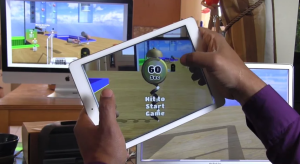At Pantomime Corporation we often say “Reach into Virtual Worlds” and “immersive reality” because we know that when people hear “virtual reality”, they picture a display worn over a user’s eyes — and we do so much more than that. In fact, the definition of “virtual reality” has changed over the years, and thanks to Ubiquitous Computing it is changing again to enjoy a wider, more interactive, social and inclusive definition.
Back in the 1990s at VPL Research, where Jaron Lanier coined the term Virtual Reality, Pantomime co-founder Dr. David Levitt was on the team that developed it. They envisioned:
- reaching into 3D virtual worlds using VPL’s founding invention, the DataGlove
- sharing worlds — since consensus is what makes reality; and
- 3D graphics — in a stereo head-mounted display with tracking we called the EyePhone
By 2014 the popular meaning of virtual reality had become mainly that last part: wearing a headset that covers your face and lets you see 3D virtual worlds in stereo, 360 degrees around you. Reaching in to interact, or being in the same virtual world with someone else, has been relatively rare.
Pantomime is working to bring back reaching in and sharing – and without requiring consumers to buy new equipment. Headsets that cover your eyes and block out the world — while those are better than ever, they’re no longer mandatory parts of virtual reality.
Because Pantomime is about the modern world of Ubiquitous Computing we’re already immersed in.
Ubiquitous Computing was predicted by 20th century visionaries like Professor Mark Weiser, Pantomime co-founder Don Hopkins’ advisor at U. Maryland. Weiser realized: in the 21st century we’ll be surrounded by so many great networked computers and displays that, instead of adding new ones to solve a problem, it will often make more sense to marshall our existing computers through software.
Pantomime is about applying that Ubiquitous Computing attitude to interactive Virtual Worlds. After all, it is the 21st century. We’re already surrounded by beautiful, networked digital screens, literally more detailed than we can see, from 1 inch to 80 inches across, everywhere we go. We already carry devices with multiple 3D motion sensors — devices we can hardly put down, even amid danger and threat of arrest. Could we look and reach into 3D virtual worlds with them?
With Pantomime we can. Pantomime has 3D models of the devices in our hands and pockets — their sizes and shapes, their screens, what they look like and how we’re moving them. With Pantomime’s patented technology we can accurately reach into first person 3D worlds with most any mobile device, join other people in them, and see into them through any of the flawless screens that increasingly surround us — whether there’s a VR headset handy or not.
And that’s great — because even today, most people don’t have a VR headset, and most 3D interactions in virtual worlds don’t require one. In a way headsets represent a privileged 1% of users — folks who are so eager to be in virtual worlds they’ll buy special equipment, brave isolation and nausea, and sacrifice mobility and interactivity to achieve it. They also sacrifice socially — wearing elite hardware, while even basics like eye contact and seeing over your neighbor’s shoulder are impossible.
Pantomime is about providing interactive virtual worlds for the 99% — and for the 1% too — by letting us all reach in and easily share using whichever devices we’ve got.
Interactive Virtual Reality for The 100%
As you discover Pantomime, if you think it’s an alternative to immersive, head-mounted virtual reality — you’re probably missing the point. It’s about reaching into any virtual world. Without Pantomime, headsets like Oculus and Gear VR don’t let the 1% reach in or share.
That will be clearer once Pantomime offers its reach-in technology integrated with headsets — letting those users play in Pantomime Playground with the rest of us. Enjoying Pantomime’s physically realistic, networked worlds can be even more amazing with a great wide angle, stereo 3D display.
Still, in the long run those exciting wearable displays may amount to 1% of our audience. The most common modes of enjoying Pantomime Playground include:
- single user tablet or phone
— interact in physically realistic worlds in 3D, seeing your device and virtual hands in mirrors - multiple users with tablets sharing over WiFi
— see each other, play, cooperate or compete as in Pantomime Playground games - tablet or phone with PC or Mac
— interact using mobile, with an added wide screen desktop or laptop view - living room style multi-player
— players teleport to a common host device, each mobile device now a game paddle or avatar control
Reality has gotten much richer since the days of VPL’s EyePhone. Today, a virtual or augmented “reality” experience should include our mobile devices, hands, computers and TVs, our table tops and other people – or it just isn’t very Real. Only Pantomime has them. Pantomime users see magic over each others’s shoulders, enjoy eye contact, and handle real mobile devices in virtual worlds — a far more authentic rendering of our modern Reality.
About a billion people already have the computers they need to reach into virtual worlds in the configurations above, and more. With so many easy ways to interact — using our favorite computers, and without having to obscure our faces or block out the world and the people around us — it’s clear reaching into virtual worlds will be much more widespread than most of us ever dreamed.


No comments yet.